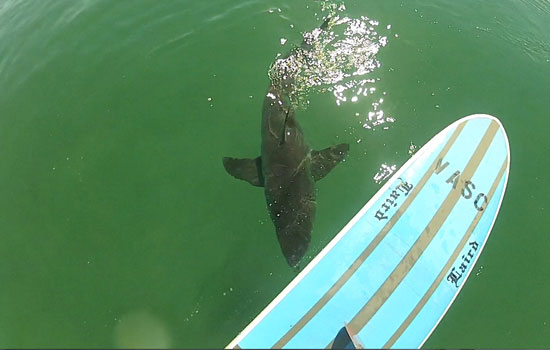The state of the shark
January 29, 2014
Last July at the end of a long beach day, a Los Angeles County Sheriff’s helicopter spotted a 6-foot-long great white shark off of El Porto Beach. The copter’s loudspeaker was so clear that some South Bay locals heard it at home in their kitchens: Exit the water immediately.
To authorities in the air, it made perfect sense to issue a warning. Down on the sand, however, the sighting was familiar to county lifeguards—a baby great white feeding on small fish and stingrays, off the coast of a county that hasn’t seen even a hint of shark trouble in 25 years.
More broadly, however, the incident underscored the recent rise in local shark encounters, and the lack of a clear, uniform local policy on how to handle them. That’s why the Los Angeles County Fire Department’s Lifeguard Division will be hosting a symposium at Dockweiler Beach on Friday for local public safety personnel, elected officials and researchers. Organizers say the event is intended partly to work toward a policy consensus and partly as an opportunity to examine the state of the great white shark on beaches here.
“To my knowledge, no one has ever been fatally bitten by a great white in Los Angeles County,” says Chris Lowe, a marine biologist who leads the Shark Lab research center at Cal State Long Beach. (A suspected 1989 attack off the coast of Malibu was handled by Ventura County and never confirmed.)
“But the sightings have gone up, and the numbers seem to be going up, too,” Lowe says. “So this is partly to bring water safety people up to speed.”
Great whites are the best known of about ten shark species that can be found off the Southern California coastline, Lowe says, but they generally prefer habitats that are rockier and colder. Female sharks are believed to migrate to this area to give birth to their offspring, which may be why the sharks that seasonally show up in our waters tend to be juveniles under 12 feet, Lowe says.
Because great whites are hard to tag, he says, their numbers are hard to pin down.
“But their populations do seem to be increasing,” he says. Theories range from cleaner water and recovering fisheries to the fact that, as a candidate species under the state Endangered Species Act, great whites are protected in California, so it is illegal to catch and kill them.
That, however, hasn’t kept thrill-seekers and shutterbugs from seeking them out in numbers sufficient to prompt another theory—that there aren’t necessarily more great whites in the water, just more cameras.
Last year, a bumper crop of SoCal shark encounters showed up on YouTube, from a viral helmet-cam clip of a young great white swimming under an audibly nervous paddleboarder to footage of a surf fisherman reeling in a 3-year-old great white near San Onofre.
“You have to be prudent,” Lowe says. “Even though most of those sharks off Manhattan Beach were babies, if someone chases and corners them, they’ll do what any animal would if it feels threatened—it will attack you. It’s generally not a good idea to chase a shark around.”
Though the few shark attacks that have occurred south of Point Conception have been in other counties, Lowe says that he can understand the desire for local consensus on policy.
“In Hawaii, for instance, we trained lifeguards and helped them develop procedures based on things like the size of the shark, whether it appears to be aggressive and whether there have been indications that people or animals have actually been bitten,” he says.
“So at this symposium, we’ll be talking about what can be done, whether to close the beaches or post notices or just pass the word to other lifeguards. And some areas may already have some of those policies in place.”
Dan Murphy, ocean lifeguard specialist for the Los Angeles County Fire Department’s Lifeguard Division, notes that local beaches fall into a variety of jurisdictions. Most are guarded by the county, but some have state or local personnel guarding the waves.
In years past, lifeguards say, the lack of a single local policy on great whites hasn’t mattered much because so few attacks happened. Baby great whites, they say, have been known to cruise right under a surfer and pose no danger.
“But that’s not to say that one of those might not take a left turn one day and chomp a stand-up paddler,” says Lifeguard Capt. Kyle Daniels, who notes that San Diego has a well-developed response policy for shark sightings. “Outside Santa Monica Bay, I’ve seen sharks eating sea lions—not at highly populated beaches, but still.”
Tom Ford, director of marine programs at the Santa Monica Bay Restoration Commission, says it is important for coastal stakeholders to educate each other as they learn more about co-existing with an important predator.
“This isn’t some scene out of ‘Jaws,’ ” he said. “These animals are part of a healthy environment and we want them to go through the course of their day without any harm to their natural movement.”
Posted 1/15/14













 405 bridge work causes a stink
405 bridge work causes a stink
